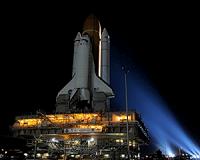 |
Paris, France (ESA) Apr 13, 2011 Today is the 50th anniversary of Yuri Gagarin's pioneering flight into space. ESA is celebrating these five decades of human spaceflight with a collection of articles, videos and interviews. "The world's first spaceship, Vostok, with a man on board, was launched into orbit from the Soviet Union on 12 April 1961. The pilot space-navigator of the satellite-spaceship Vostok is a citizen of the USSR, Flight Major Yuri Gagarin." To the world of 1961, this was an electrifying announcement, made while Gagarin was still in space. The Americans were stunned, but the congratulations they sent to Moscow were genuine. This historic 108-minute flight, orbiting Earth once, made Gagarin the first human in space, and a global hero. He was only 27 years old. His feat was historic. NASA rushed to get an astronaut into space and, the following month, Alan Shepard became the first US astronaut, albeit making a brief suborbital ballistic flight. It was not until the next year that an American astronaut reached orbit, when John Glenn circled Earth in his Mercury capsule. Two days after the return of Vostok-1, Gagarin was back in Moscow, where he appeared on the Kremlin balcony with Premier Nikita Khrushchev. Forty-eight hours earlier, he was unknown; now he was arguably the most famous man on Earth. He embarked on a worldwide tour, greeted by cheering crowds wherever he went. Gagarin's international visits were remarkable because they came at the height of the Cold War. Here was someone who could travel not only between Earth and space, but also between the open and closed worlds of east and west. Ideological differences were momentarily forgotten as he was hailed around the globe. Gagarin never flew in space again. After touring, he returned home to Star City to continue his work in the Russian space programme. He was in training for an early flight of the new Soyuz spacecraft in 1967, but was grounded by senior space managers who did not want to risk him in another hazardous mission. It is even more of a tragedy, then, that he lost his life during a routine training flight, on 27 March 1968, when his plane crashed. His ashes were placed in the Kremlin Wall and a lunar crater and asteroid 1772 Gagarin are named in his honour.
Share This Article With Planet Earth
Related Links - Space Tourism, Space Transport and Space Exploration News
 Witnesses Say Future Of NASA Human Space Flight Is Uncertain
Witnesses Say Future Of NASA Human Space Flight Is UncertainWashington DC (SPX) Apr 01, 2011 today, in a hearing of the Subcommittee on Space and Aeronautics, witnesses expressed serious concern about the lack of clear focus by the Administration on NASA's transition from the Space Shuttle program toward development of the Space Launch System (SLS) and Multi Purpose Crew Vehicle (MPCV). These vital components of NASA's human space flight program were outlined as top priorities in the NA ... read more |
|
| The content herein, unless otherwise known to be public domain, are Copyright 1995-2010 - SpaceDaily. AFP and UPI Wire Stories are copyright Agence France-Presse and United Press International. ESA Portal Reports are copyright European Space Agency. All NASA sourced material is public domain. Additional copyrights may apply in whole or part to other bona fide parties. Advertising does not imply endorsement,agreement or approval of any opinions, statements or information provided by SpaceDaily on any Web page published or hosted by SpaceDaily. Privacy Statement |